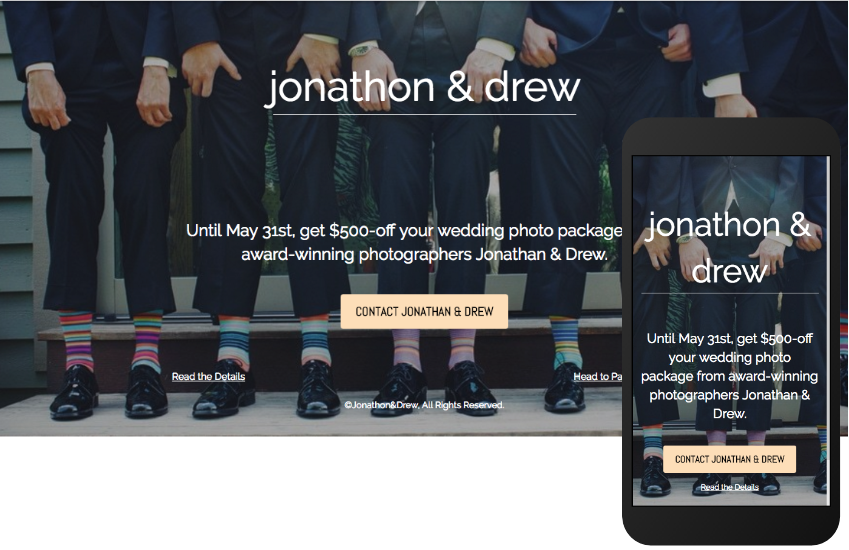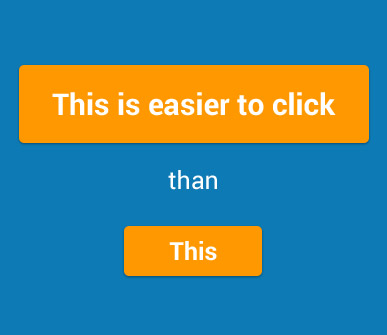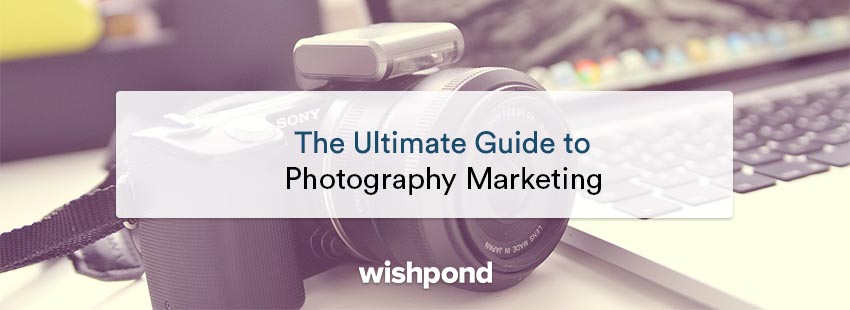
The Ultimate Guide to Photography Marketing: Everything Photographers Need To Know
There’s more to running a photography business than technical skills.
An integral part of a successful photography business — whether individual or an agency — is marketing your services. That might feel like a foreign skillset, and you might be far more comfortable behind the camera than pushing yourself into the spotlight.
Luckily, today, digital marketing tools have made it easier than ever to showcase your talent, attract customers and promote your business, without doing any cringe-worthy sales pitches.
At Wishpond, we’ve helped photographers establish and run their online presences for years. We’ve collected our hard-earned wisdom and summarized it into one ultimate photography marketing post. Here, we’ll cover marketing strategies in multiple forms: how to showcase your photography business online, how to attract customers and how to keep them engaged.
Your Website
Working today, you’ll know the importance of having an online presence.
Your website is a key part of the impression you’ll make online, and it’s a brilliant opportunity to show potential clients your personality — and your skill — through every element of your design.
To help walk you through the different aspects of photography marketing, we’ll use this customized example of Jonathan and Drew.
This would be Jonathan and Drew’s website homepage.

It’s clean, striking, highly emphasizes visuals (absolutely essential in established credibility for a photographer’s website), the call to actions are clear and it’s mobile responsive.
Note how quickly, as a user, you understand what the website is about, and how all the elements work together. Without moving beyond the fold of the homepage, you can get a feel for the personality of the business (these photographers are probably more traditionalists than quirky, avant-garde photographers) and you know at the outset they specialize in weddings.
From a technical standpoint, the site works equally well on mobile and desktop. Keeping the layout impactful and appealing on mobile is more important than you think. With the majority of users navigating the web on their smartphones, your website should be designed to guide them through the experience on a small screen.
Although you might be designing on a desktop, it’s crucial to be working with a service that has mobile-responsive templates, or design a mobile-responsive version of your site.
Ensure your test your site before launch and view it on different types of mobile devices and screen sizes (if possible).
Landing Pages
Another important conversion point is landing pages. There’s an important distinction between your landing page and your website that people get confused: they aren’t the same thing.

Marketing pro tip: Although people often confuse the two, a landing page and a website aren’t the same thing.
Your landing page shouldn’t be a stand-in for your website. Your landing page is where people come after a specific offer you’ve made, from a blog post or a Google Ad, for example.
A previous article stated that visitors should be able to glean what your landing page is about and what it’s offering them within 7 seconds of arriving on your page.
That may sound like a tall order, but it’s fairly simple to do if you follow a few guidelines. Let’s revisit Jonathan and Drew.
One of their landing pages might look like this:

- Tip one: Don’t crowd your page with copy. Make it about your offer. They can find out more about your business, your past work, your favorite color on your website.
- Tip two: Make your central image closely tied to your business and your copy.
- Tip three: Give your users one call to action. Don’t offer a newsletter sign up on a landing page for a 50% off coupon.
- Tip four: Make it easy to covert! This is where details matter. Do what you can to increase your loading speeds and reduce friction. This means bigger buttons and shorter forms.
Take a look at this simple example:

Remember: just because your landing page isn’t as comprehensive as your website, doesn’t mean they require less thought.
Further reading:
- Landing Pages: An Introduction for Photographers https://blog.wishpond.com/post/115675435217/landing-pages-an-introduction-for-photographers
Social Media
A behind-the-scenes look
Photographers have incredibly interesting jobs. They do!
It may not feel like it to you, but the idea of documenting the world for a living is fascinating to many people.
Your job provides you with a great narrative, just by its nature. Social media gives you a way to tell your story, build followers, showcase your expertise, build your brand, and — as a result — your client roster. It’s content marketing, at its most unfiltered.
Your social media posts can be as quick as an insider look at a photoshoot, a months-long expedition trek diary or how-tos on photography techniques. Really, anything you feel like writing about!
National Geographic photographer Paul Nicklen is well known for his ability to leverage social media to promote environmental conservation, with stunning images from the unexplored corners of the earth, outtakes from conservation expeditions, scientific research and more.
Yet here, he updates his followers with no message in particular, just a happy, sleepy seal.
The important thing with social media is maintaining a consistent voice and posting content that users will find engaging and want to interact with.
Whether that’s for its important social message, the technical skill involved in getting the photo you post, or because there’s a warm, furry baby mammal involved, that’s up to you!
A mini-gallery
Photographers have an edge when it comes to social media, one of the most visual mediums.
With an inherent sense of what’s eye-catching and a library of unique usable images, you already have a jump on the market. What’s your job is knowing how to use it.
Instagram’s square canvases may at first appear limiting, but within them, they offer a lot of room for creativity.

Marketing pro tip: Instagram’s square canvases may at first appear limiting: but within them, they offer a huge amount of room for creativity!
Take, for example, former White House’s photographer Pete Souza’s Instagram.
View this post on Instagram
His Instagram might not have the photos chosen for official publication, but that might be part of its appeal. It showcases his talent and skill, the more human side of his subjects and has managed to rack up 2.1 million followers.
Photographer macenzo has used a keen understanding of design and geometric shapes to show how to use an overall feed to maximum advantage.

Paid Ads
Increasingly, social media platforms are becoming pay-to-play. If you have the budget, it’s not a bad idea to run limited ads on offers.
Never done a social media ad before? We’ve got you covered. Let’s go back to Jonathan and Drew.

Note, this ad will probably lead to their landing page and uses the same image as the landing page background. This will give users who click through a sense of continuity and the assurance they’ve arrived at the right place, solidifying trust in the brand.
Social media ads are notoriously text light. This isn’t an industry-wide stylistic choice: Facebook has stringent guidelines that only allow ads to have a certain amount of text in their image before it hurts reach.
Facebook’s text overlay checking tool can help you check if yours meets the guidelines.
Video ads are high impact. As photographers, you may be less interested in video than photo, but if you do want to experiment with video photography, keep a few things in mind:
- Shoot vertically, not horizontally, to optimize for mobile.
- Try not to have too much of your video’s power rely on sound (and add captions) in case your user has the sound muted, is in a noisy area, or has hearing difficulties.
- Try to use bright and eye-catching images.
Further reading:
- 10 Best Facebook Ads Changing The Game.
- How to Use Facebook Ads for Local Businesses (And Why They Work)
- 6 Facebook Ad Image Best Practices that will Send your Click-Through-Rate to the Moon
Social Media Contests
A common mistake entrepreneurs on social media make is limiting themselves to promoting their content.
Social media is a two-way street, and interactivity is one of the best ways to leverage their power. Contests are one of the best ways of doing that.
As photographers, you have a very in-demand skillset: there are people who both want your services, and also want to learn your craft.
As a result, you have a lot to offer as a contest prize. You can offer giveaways of old gear, tutorial sessions for new photographers, editing sessions, discounts, or photoshoots for special occasions.
The only thing we’d caution against is pouring too much into a lot of expensive gear as a contest prize. It seems tempting, and while you might get a lot of entries, the more expensive the prize, the less likely it is that all your entrants will be genuinely interested in your specific service, and the more likely they are to be purely entering for the high value of win.
The short-term value of the buzz around your competition may not be worth a huge price tag of a set of premium gear, which can be into the thousands of dollars.
Further reading:
- 30 Amazing Social Contest Ideas and Examples
- Running a Contest on Facebook
- Running a Contest on Instagram
Email Marketing
You may not have considered email marketing, but even a simple workflow: a welcome email, a coupon, a newsletter (if you’re into writing)– any of these can make a huge difference to your business.
Email marketing’s ROI is the highest of any marketing method. In a noisy marketing landscape, messages that land right in your subscribers’ inboxes feel more personal and are much more likely to make an impression.
As a photographer, a lot of the value you may find in email marketing is in keeping in touch with former clients.
Retention, Referrals, References
Satisfied former clients are your business’ best friend. They are more likely to purchase again and can act as referrals. Email marketing is a great, non-intrusive way to keep in touch with them.
Additionally, customers trust reviews from customers more than almost anything else. They don’t just want to see your photos: they want to know you’re easy to work with, trustworthy, that you’ll understand the importance of their event or their photo set.
Getting in touch with former clients to ask for reviews is okay, if you have a solid customer relationship established and you know they were happy with your service!
Pop-ups

We may gripe about pop-ups, but they are also a highly effective lead generation tool. A well designed pop-up, on a page not cluttered with other ads, can feel more like an opportunity than an intrusion.
Offering coupons, subscriptions to your newsletter, ebooks — anything that can benefit your audience — is a great use of the space.
Be sure to place your pop-up somewhere that makes sense. I.e. placing an offer for a 50% discount coupon on a landing page for another offer that makes users ineligible to use the 50% discount coupon? Not a great idea.
Placing a subscription offer to sign up for your newsletter if you’ve written an article or blog post the user has been scrolling through? That makes much more sense!
Summary
We know this has been a lot to digest, but if you take it step by step, you’ll have a robust (and masterful!) online photography marketing strategy in no time — without even realizing it!
As a recap, here are the five areas photographers can focus on in digital marketing to amplify their message and build their business.
- Website: Keep it highly visual and mobile responsive. It should be an extension of your personality. If you are a quirky, offbeat freelancer who prefers bright colors and experimentation, for example, don’t go for a minimalist, classic website that will attract an entirely different clientele.
- Landing Pages: Not the same as your website, a landing page is nonetheless an important conversion point. These are where readers go after clicking on a specific link for an offer, e.g. to download an ebook or sign up for a coupon. While not as hefty as websites in terms of content, it’s nonetheless important to put thought into their design.
- Social Media: Show off your creativity and use it as another channel to reach your audience with paid ads.
- Email Marketing: Leverage it for retention, referrals, and references.
- Pop-Ups: Ensure they are well designed, offer value, and place them somewhere that makes sense for your user.


